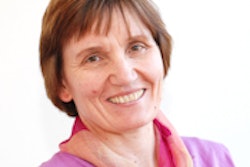Mammography images can look significantly different based on whether they were acquired with a digital or analog system. But such differences in appearance don't seem to affect the ability of radiologists to score breast density accurately, according to a study in the March issue of Radiology.
The finding indicates that automated measurements of breast tissue density could be developed and used with BI-RADS categories, streamlining the density assessment process for radiologists and their patients, wrote the group of researchers from several U.S. institutions.
Breast tissue density is associated with an increased risk of breast cancer. But how breast density is assessed remains variable, depending on the reader. This problem has sparked efforts to develop breast cancer risk models that can standardize how women's breast tissue is categorized.
At the same time, breast imaging is in the midst of a shift from analog film-screen mammography to full-field digital mammography (FFDM), with digital units making up 82% of mammography systems certified by the U.S. Food and Drug Administration (FDA) as of November 2011. Radiologists have already noted the different appearances of images acquired with the two techniques; could they also differ in how they render breast density?
Lead author Dr. Jennifer Harvey, from the University of Virginia, and colleagues hypothesized that BI-RADS breast density categories would be lower with FFDM, because of the technology's higher contrast resolution and improved visualization of the whole breast area, compared to film-screen mammography. Therefore, the categories would have to be adjusted depending on the mammogram acquisition method (Radiology, March 2013, Vol. 266:3, pp. 752-758).
However, in the study, the team found no difference between FFDM and film-screen mammography in reported BI-RADS breast density categories.
"Radiologists have adjusted for different acquisition methods, and we're more consistent than we think when categorizing breast density," Harvey told AuntMinnie.com.
Harvey and colleagues collected demographic data, risk factors, and BI-RADS breast density scores from five mammography registries that were part of the Breast Cancer Surveillance Consortium. The study included 435,751 women 40 years and older who underwent at least two screening mammographic examinations fewer than 36 months apart between January 2000 and December 2009. Women with a history of breast cancer were excluded.
The researchers evaluated a main sample and a comparison group. The main sample included 89,639 women who received both analog and digital mammograms. Meanwhile, the comparison group consisted of 259,046 women with two film-screen mammograms and 87,066 women with two digital mammograms.
Regardless of the image acquisition method, the percentage of women with a change in density from one reading to the next was similar, according to Harvey and colleagues. Breast density was lower in 19.8% of the women who had film-screen exams before FFDM and in 17.1% of those who had digital exams before analog mammography.
In addition, a similar percentage of women had lower density on the second exam, regardless of type (15.8% to 19.8%). Agreement between density readings was consistent regardless of mammographic types paired, varying from 67.3% to 71%.
Film-screen and digital mammograms can have very different appearances because of film and image processing methods and manufacturer-specific display protocols, Harvey and colleagues wrote. But the study showed no difference in how radiologists assigned BI-RADS breast density categories regardless of acquisition technology -- which is significant for clinical practice.
"The implications of this study are important if reported BI-RADS density categories are to be included in breast cancer risk models and for studies that combine visual breast density measurements from [film-screen] and digital mammograms," Harvey's group wrote.
Reader variability still exists, which is why developing automated measurements of breast density is crucial, Harvey told AuntMinnie.com. But that variability is consistent across modalities.
"There are still variations in breast density categorization from reader to reader, but that variability is the same, whether digital or film-screen mammography is used," she said.



















